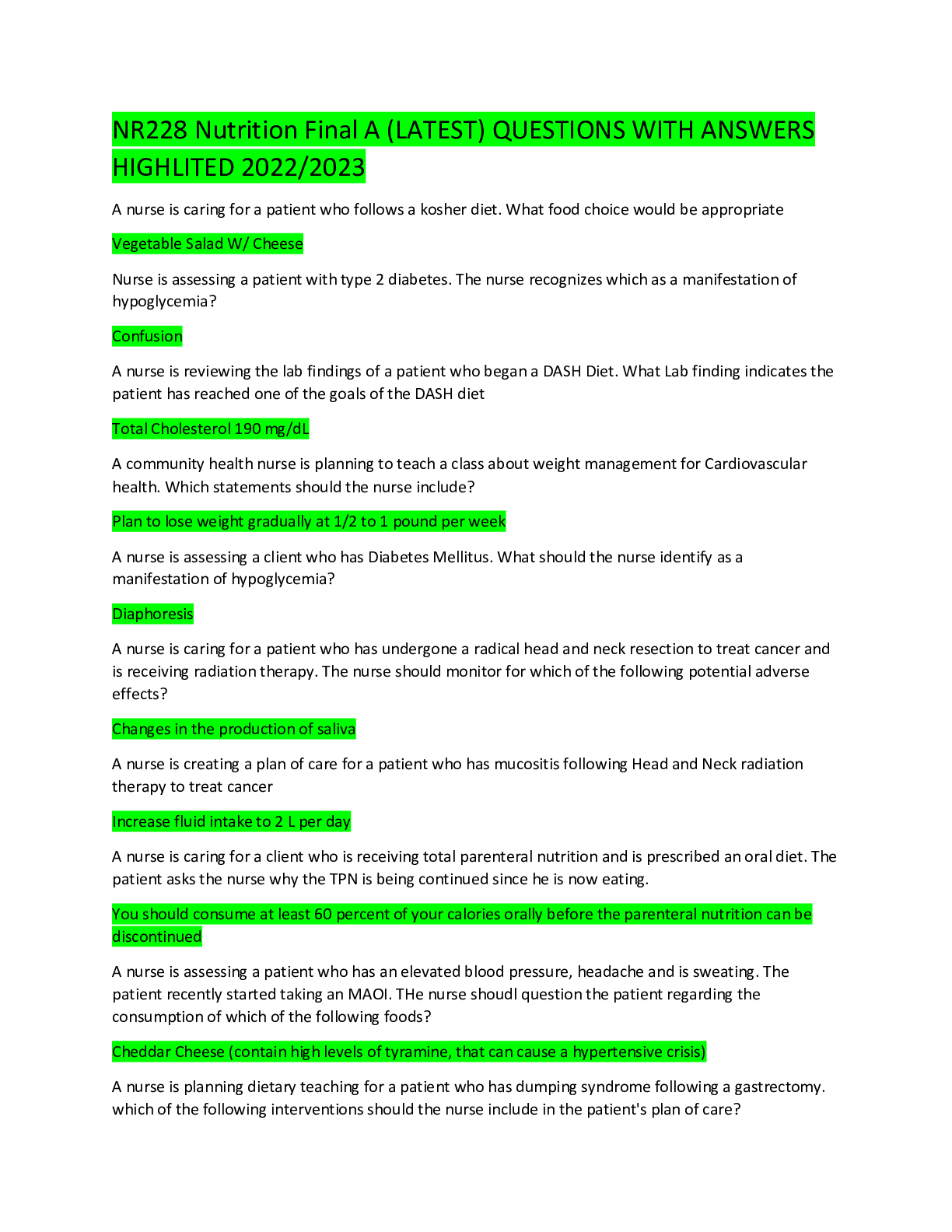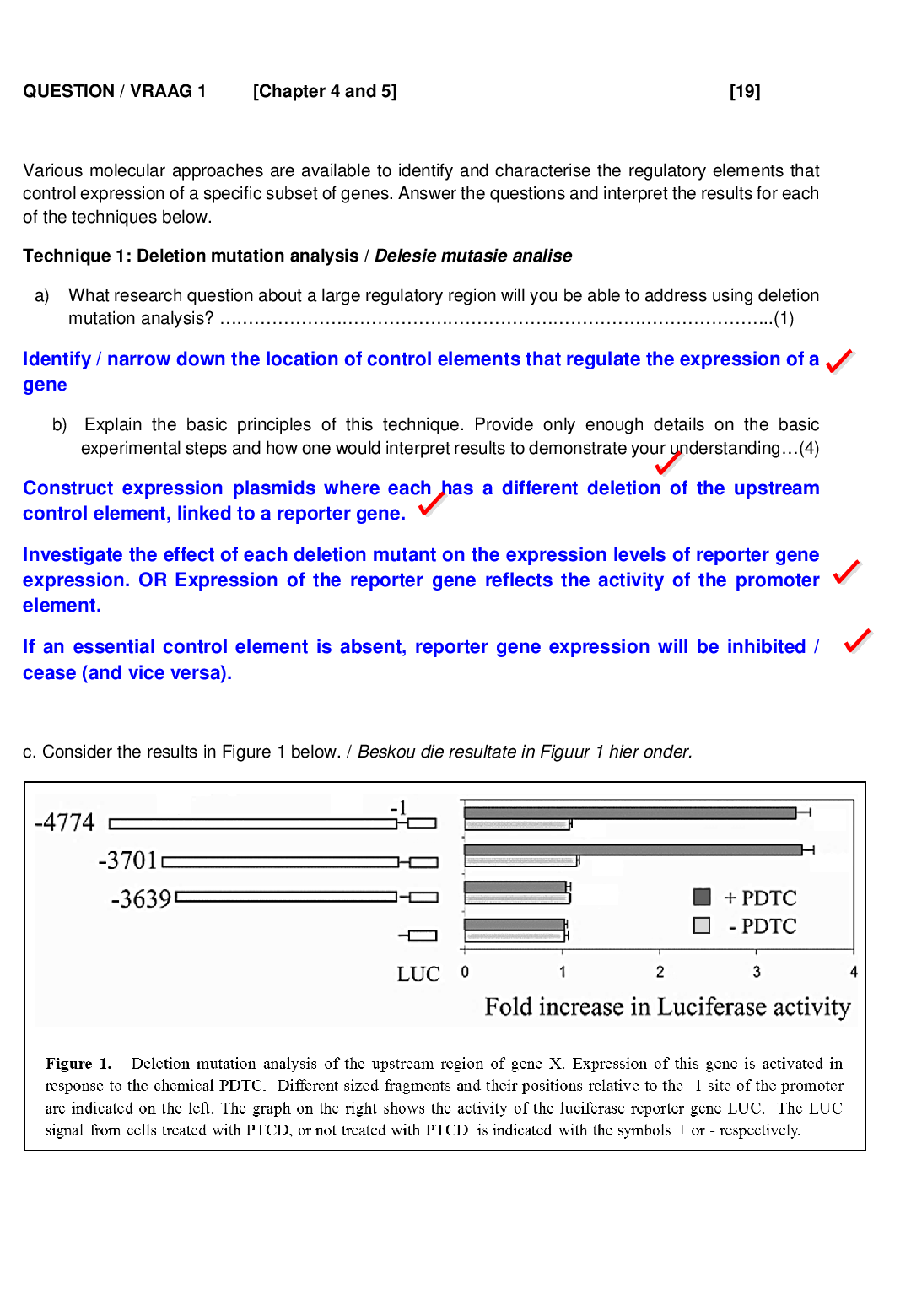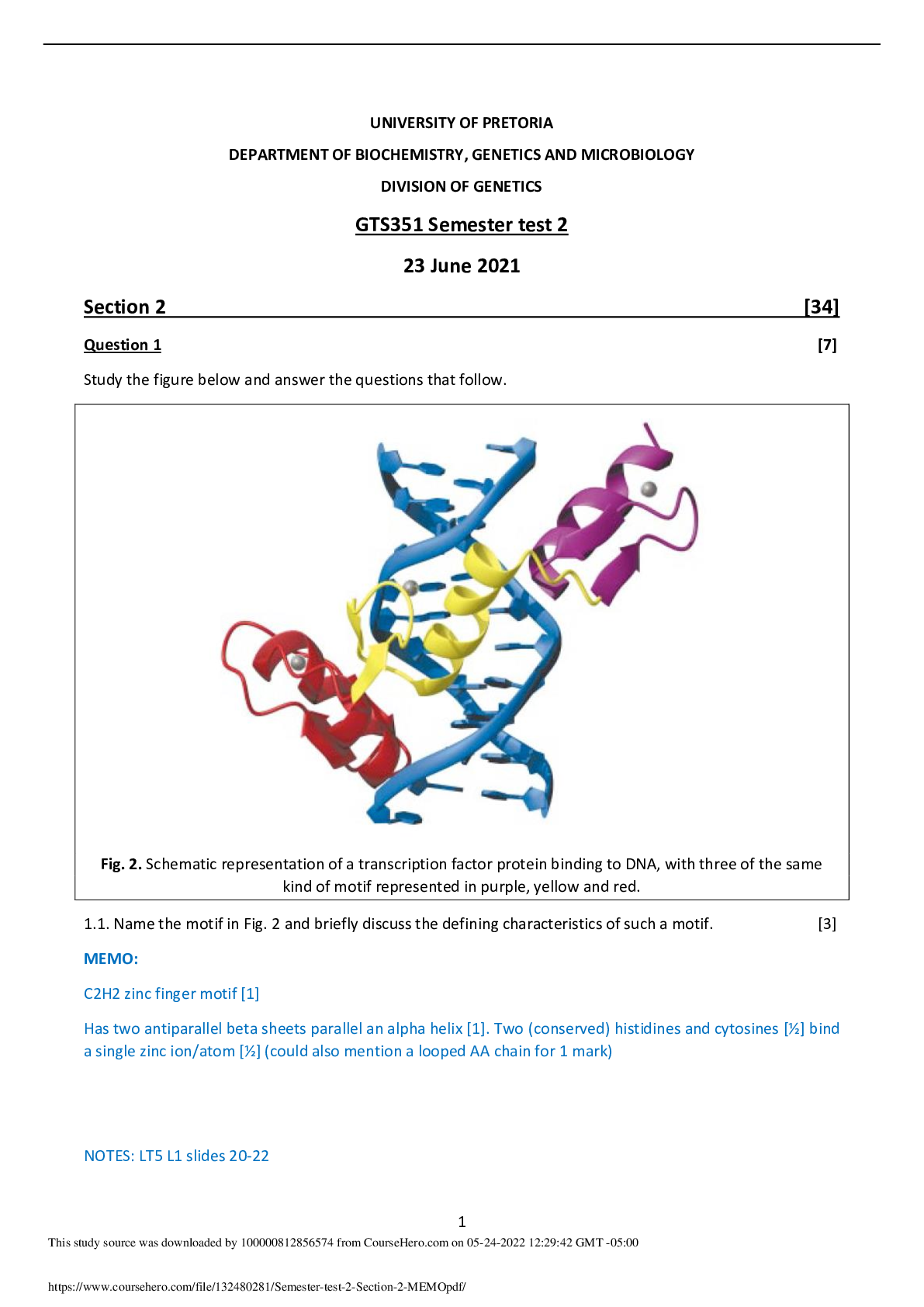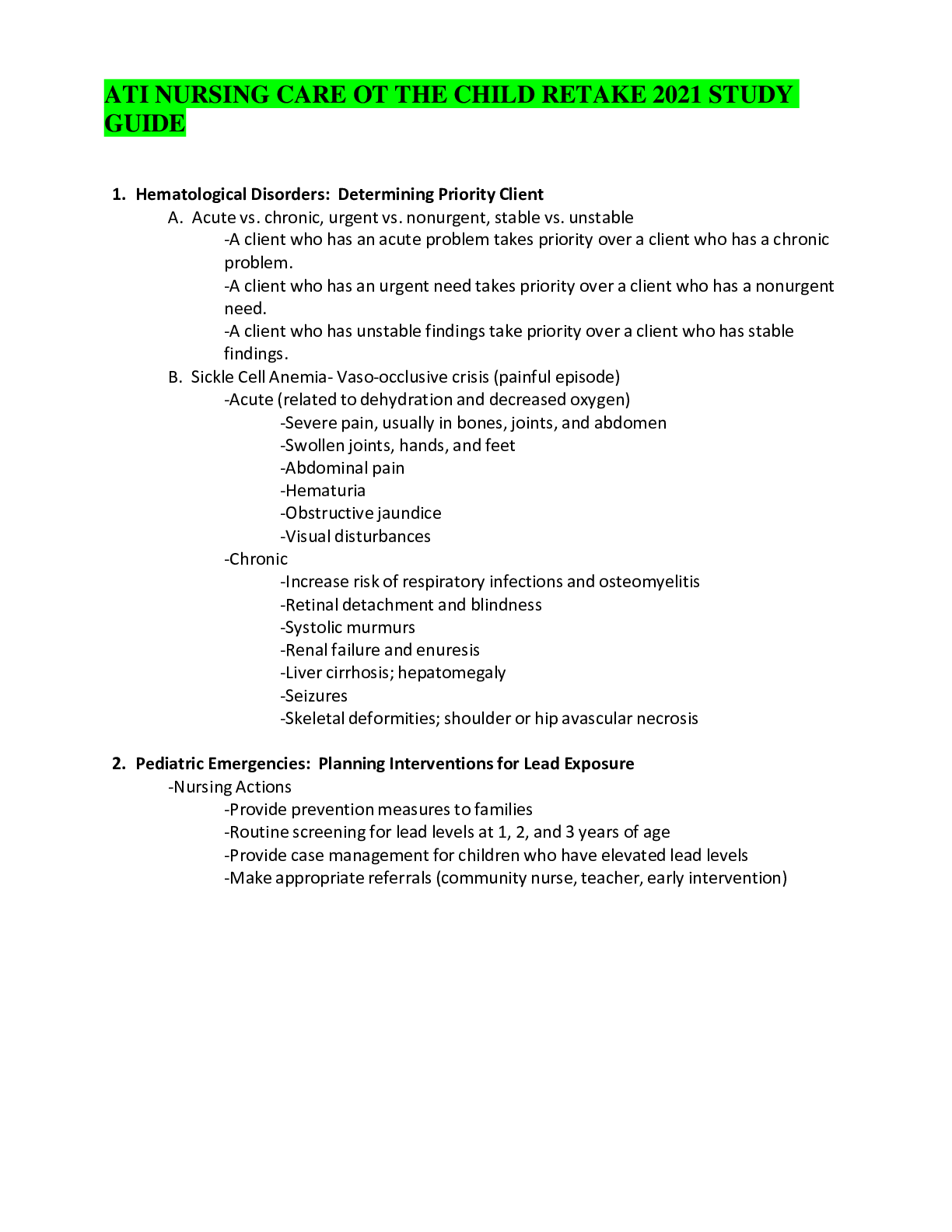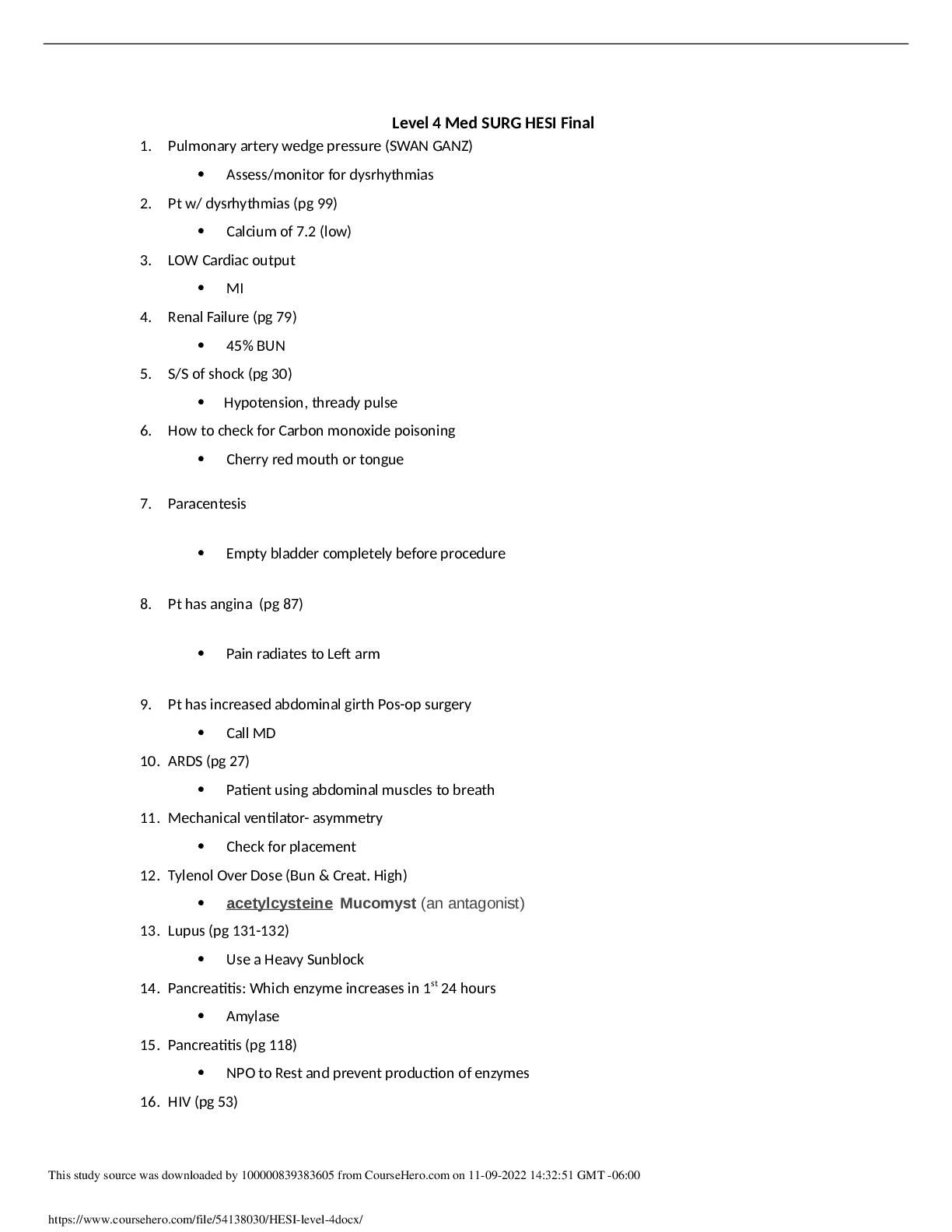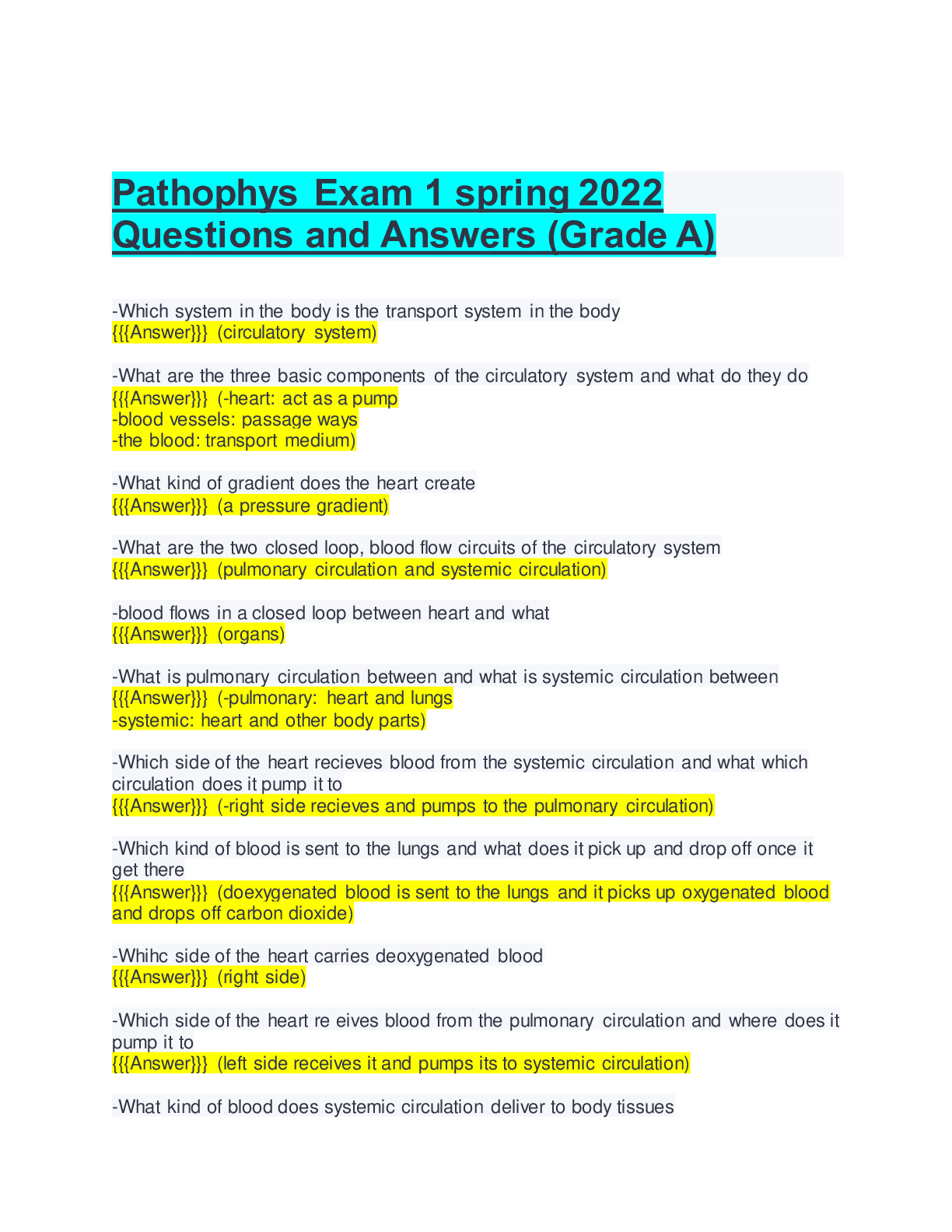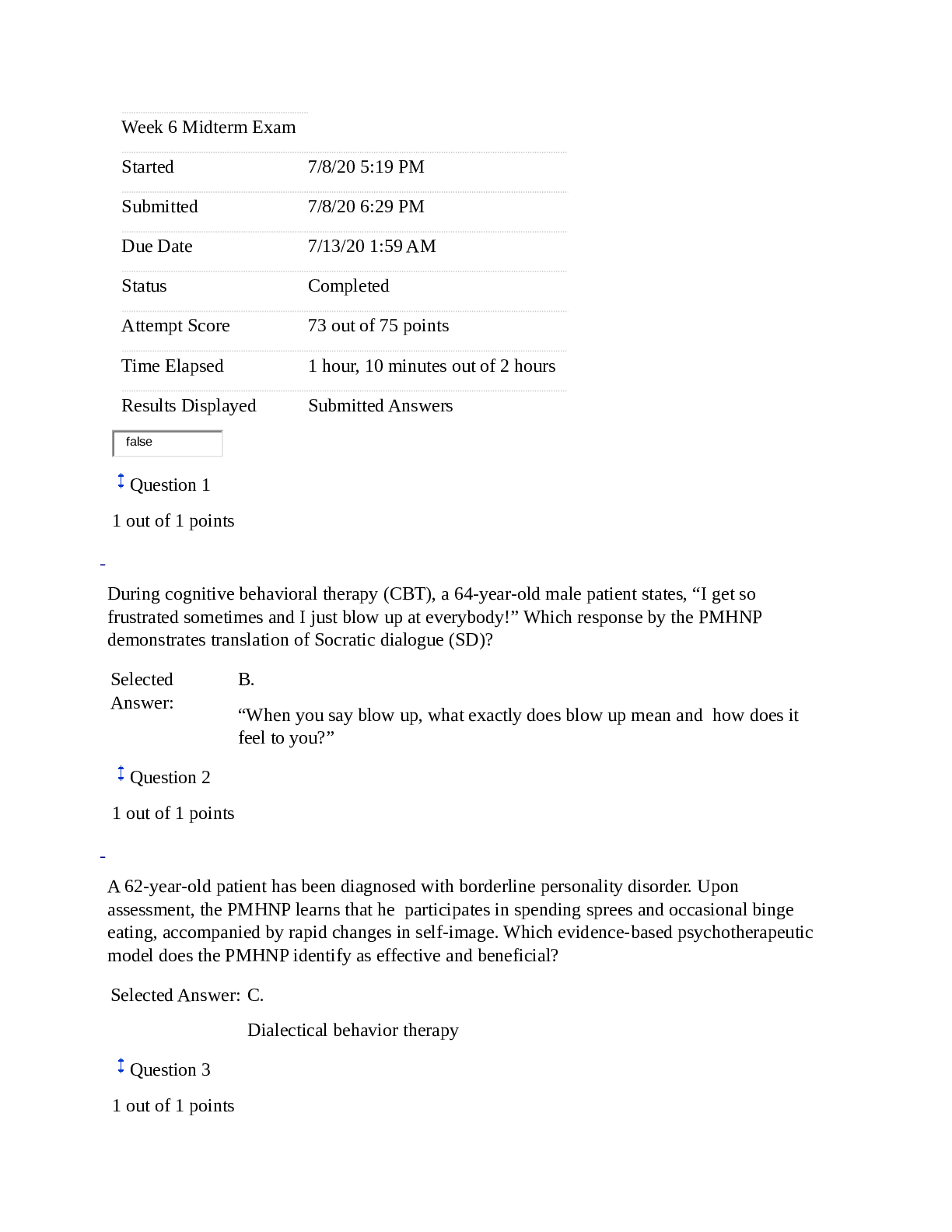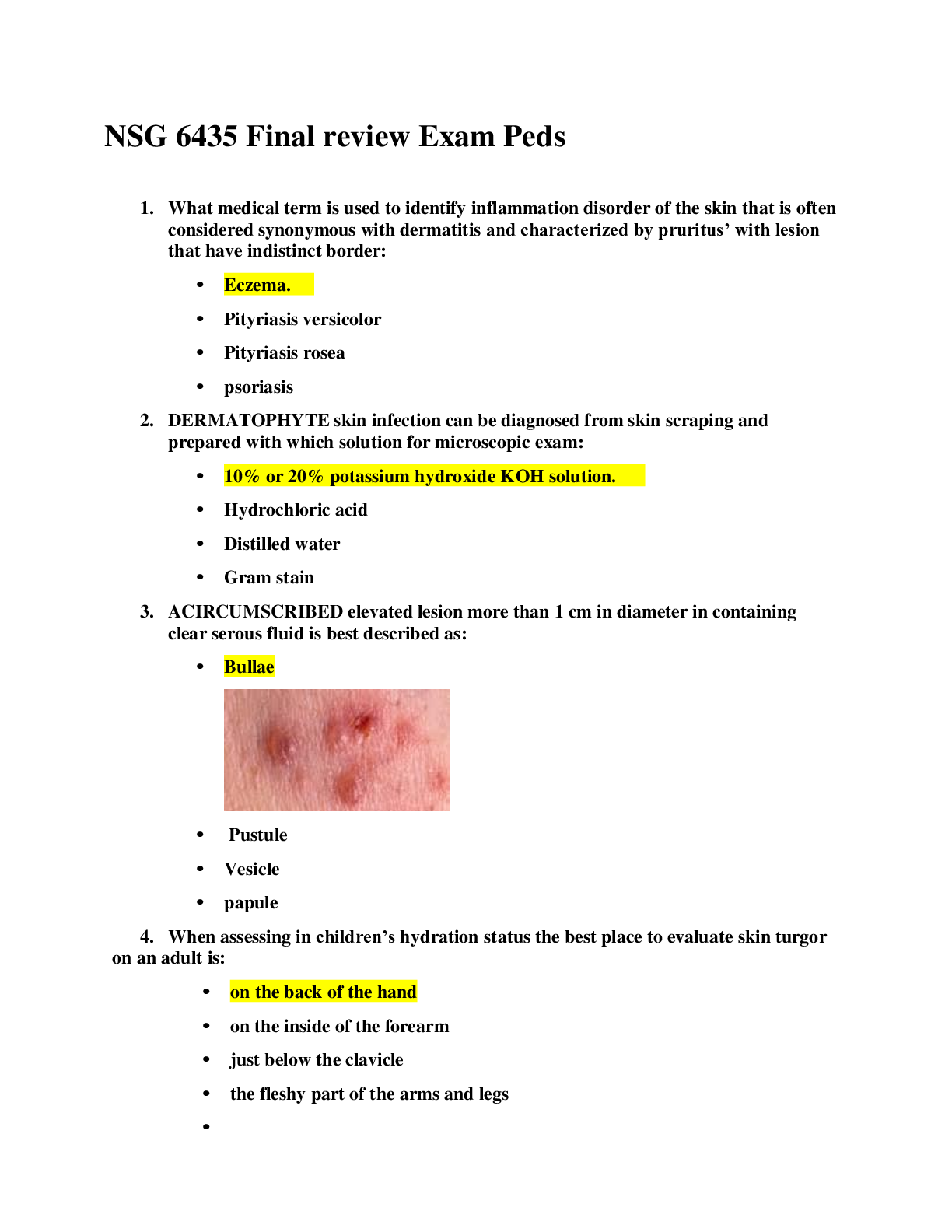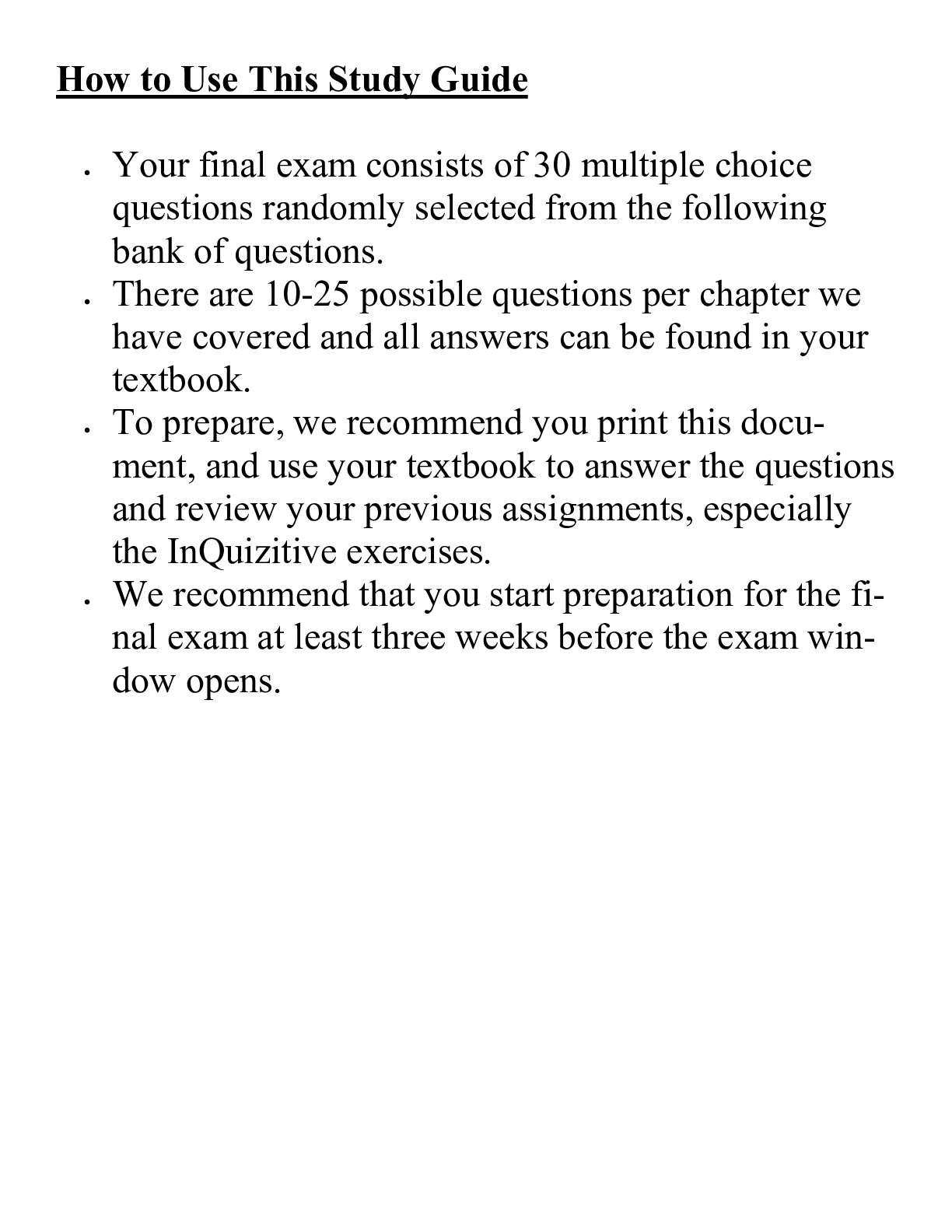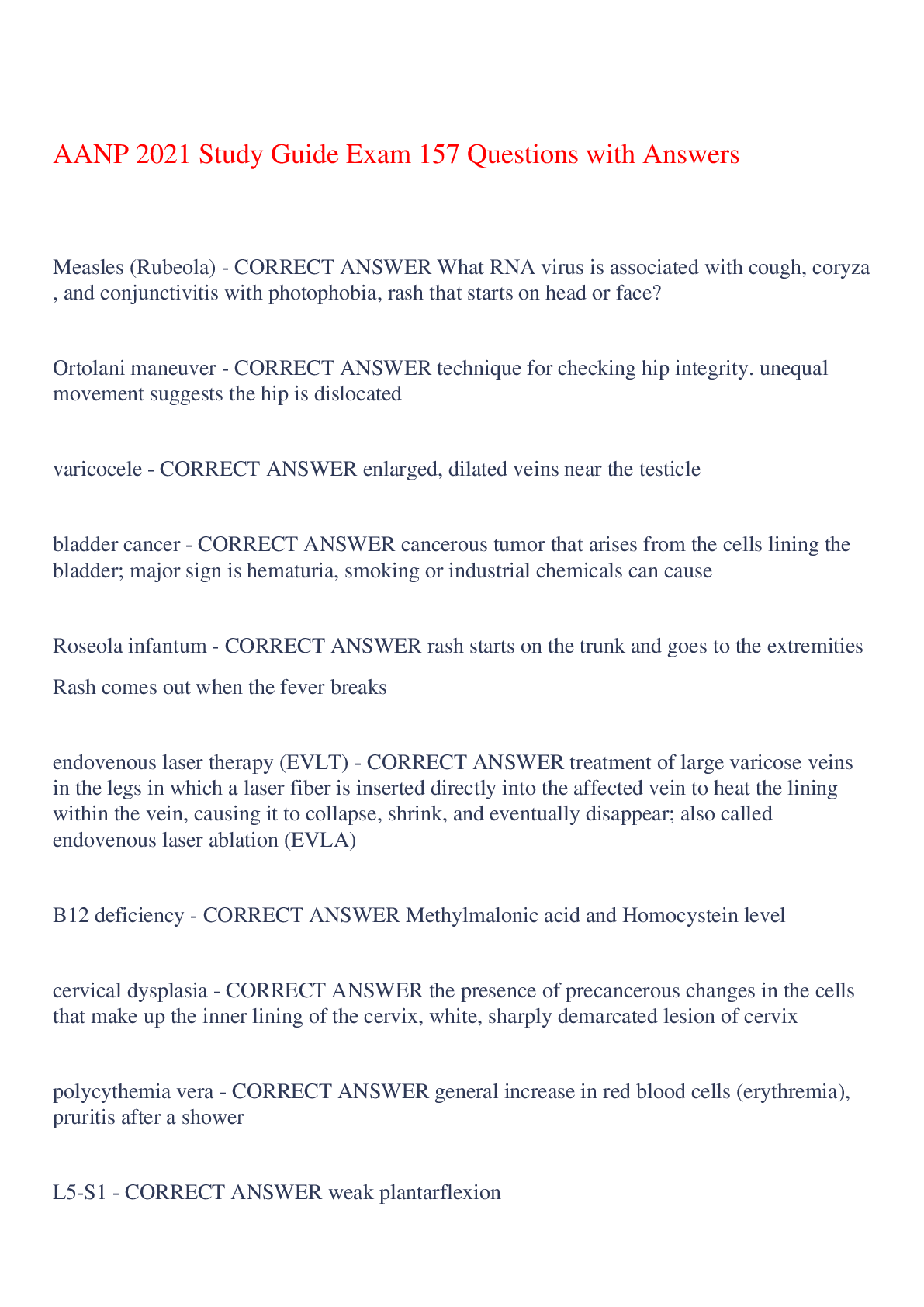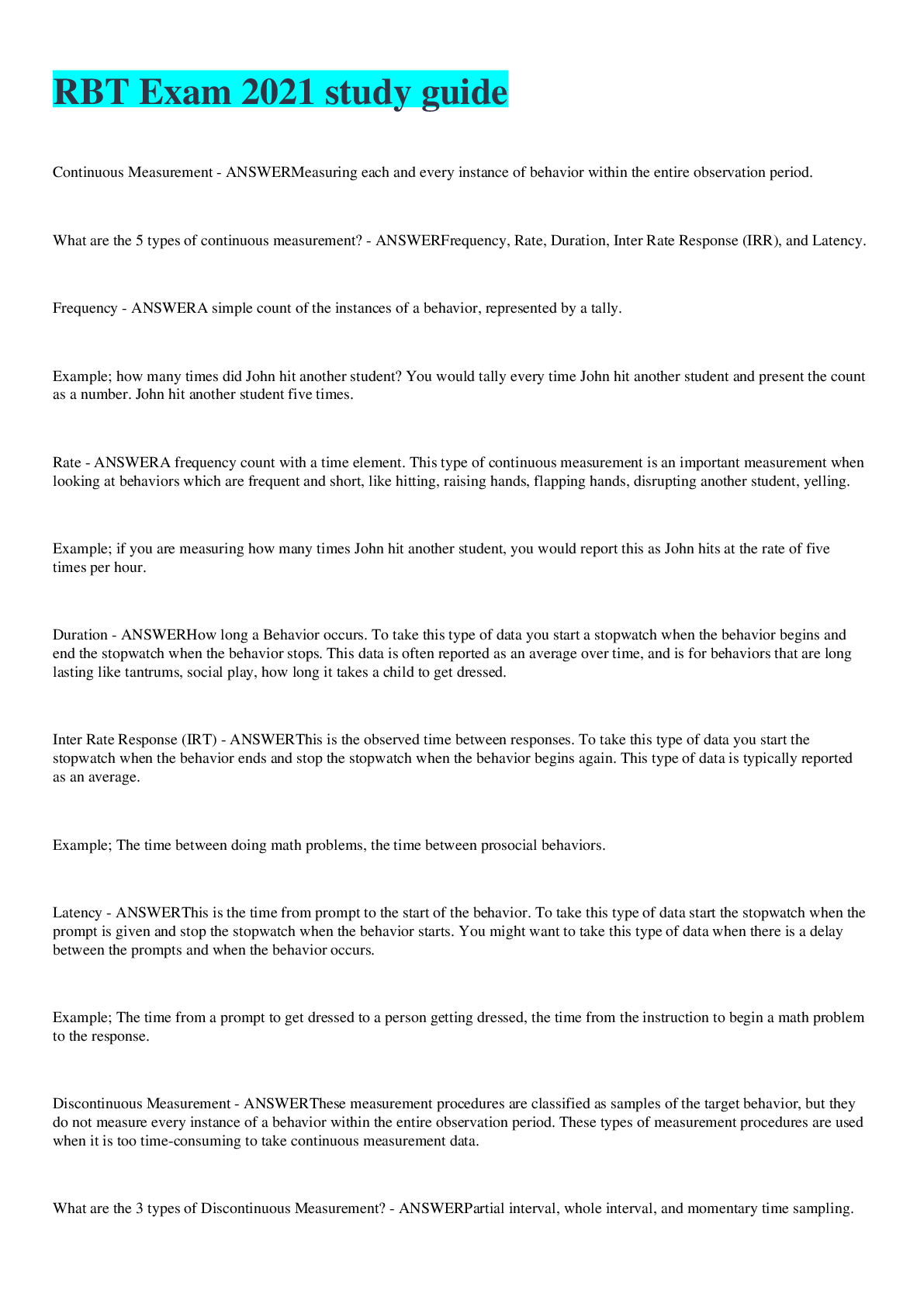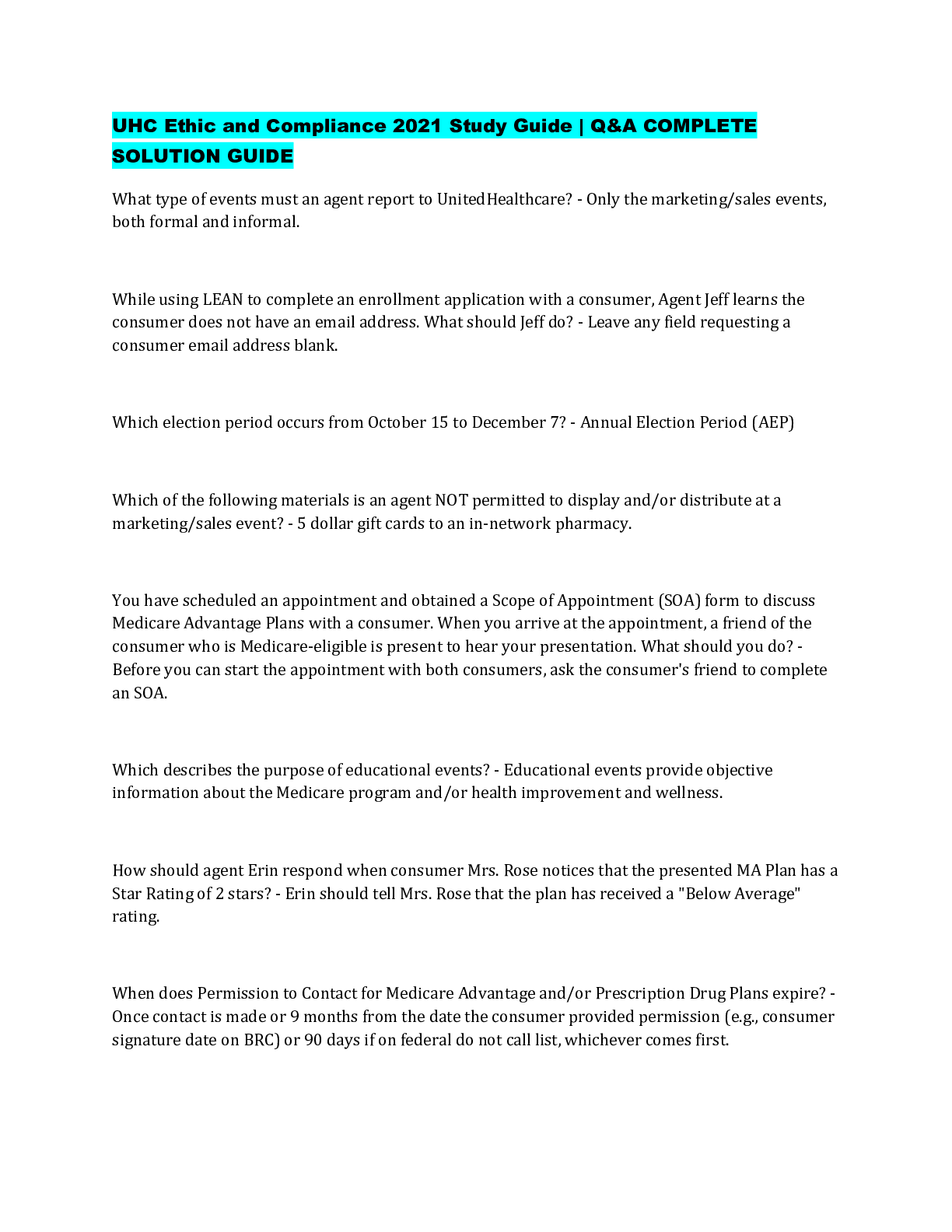Nursing 102 Exam 1 Spring 2021 STUDY GUIDE GRADED A
Document Content and Description Below
Nursing 102 Exam 1 Spring 2021 The nurse is caring for a patient who has diabetes mellitus and circulatory insufficiency, with peripheral neuropathy and urinary incontinence. On which areas does th... e nurses focus care? Decreased pain sensation and increased risk of skin impairment. Rational: Patients with paralysis, circulatory insufficiency, or peripheral neuropathy (nerve damage) are unable to sense an injury to the skin (decreased pain sensation). The presence of urinary incontinence, circulatory insufficiency, and neuropathy can combine to result in breakdown, so the patient has an increased risk of skin impairment. While the patient may have decreased caloric intake, the patient will not have accelerated wound healing with circulatory insufficiency, neuropathy, and incontinence. While the patient is at high risk for skin infection, the low salivary pH level is not an issue. While the patient may have a high risk for impaired venous return from the circulatory insufficiency, there is no indication the patient has dementia. A student has been assigned to provide hygiene care to four clients. Which one would require special consideration for perineal care? Middle-age woman with a Foley catheter. Rational:Chapter Number: 31 Hygiene Client Needs: Physiological Integrity: Basic Care and Comfort Cognitive Level: Apply Page: 990 Feedback: The dark, warm, moist perineal and vaginal areas favor bacterial growth. Variables known to create a need for special care include an indwelling Foley catheter. The client who cannot clean the perineal area needs the nurse's assistance for personal hygiene. Hernia and cosmetic surgery and NG tube do not require special perineal care. A client with an upper respiratory infection (common cold) tells the nurse, " I'm so angry because the nurse practitioner would not give me any antibiotics." What would be the most appropriate response by the nurse? Antibiotics have no effect on viruses ( Ch. 24 Asepsis and infection control p. 597) A nurse is caring for an adolescent who is diagnosed with mononucleosis, commonly called "the kissing disease." The nurse explains that the organisms causing this disease were transmitted by: Direct contact (Ch. 24 asepsis and infection control P. 598) Which questions asked by the nurse when taking a clients health history would collect data about infection control? When did you complete your immunizations? (Ch. 24 Asepsis and infection control p.602) A nurse has seen several clients at a community health center. Which client MOST at risk for developing an infection? an older adult with several chronic illnesses ( ch.24 asepsis and infection control p. 601) A nurse is educating adolescents on how to prevent infections. What statement by one of the adolescents indicates that more education is needed? I don't wear a condom when I have sex, but I know my partners. (ch. 24 p. 601-602) A female client is on isolation because she acquired a methicillin-resistant staphylococcus aureus (MRSA) infection after hospitalization for hip replacement surgery. What name is given to this type of infection? Healthcare-associated (HAI) (CH. 24 PG.608) The following procedures have been ordered and implemented for a hospitalized client. Which procedure carries the greatest risk for a healthcare associated infection (HAI) Urinary catheterization (ch.24 p.608) A nursing home recently has had a significant number of nosocomial infections. Which measure might be instituted to decrease this trend? Have written, infection-prevention practices for all employees (ch.24 p. 619) A nurse has completed morning care for a client. There is no visible soiling on the nurse's hands. What type of technique is recommended fir hand hygiene? Clean hands with an alcohol-based hand rub. (Ch. 24 p. 606) The infection control nurse will be educating the clinical staff about a new infection control initiative that is being introduced at the health care facility. The initiative will further emphasize the need for hand hygiene. What information is important for the infection control nurse to include when educating the clinical staff? Full compliance with hand hygiene is difficult to achieve. (CH. 24, PG. 606) A nursing student is performing a urinary catheterization for the first time and inadvertently contaminates the catheter by touching the bed linens. What should the nurse do to maintain surgical asepsis for this procedures? Gather new sterile supplies and start over. (Ch. 24, p.617) A nurse is performing a sterile dressing change. If new sterile items or supplies items or supplies are needed. How can they be added to the sterile field? With sterile forceps or hands wearing sterile gloves...STERILE TO STERILE (ch. 24 p. 617) A nurse is changing the bed linen of a client admitted to the health care facility. Which isolation precaution should the nurse follow? Standard precautions (ch. 24 p. 614) An experience nurse is educating a student nurse on the proper use of hand hygiene. What is an accurate guideline that should be discussed? Hand hygiene must be performed after contact with inanimate objects near the client. (ch.24 p. 604-605) Upon auscultation of a client's heart rate, the nurse notes the rate to have an irregular pattern of 72 beats/min. The nurse notifies the physician because the client is exhibiting signs of ? A dysrhythmia (ch. 25 vital signs , p654) A male client 86 years of age with a diagnosis of vascular dementia and cardiomyopathy is exhibiting signs and symptoms of pneumonia. The nurse has attempted to assess his temperature using an oral thermometer, but the client is unable to follow directions to close his mouth and secure the thermometer sublingually. Additionally, he repeatedly withdraws his head when the nurse attempts to use a tympanic thermometer. How should the nurse proceed with this assessment? Assess the clients temperature by axilla (ch. 25, pg. 652) Which client will the nurse monitor the vital signs every four hour? A client hospitalized with hypertension (ch.25, p 643) A client is constipated and trying to have a bowel movement. How does holding the breath and pushing down (the Valsalva maneuver) affect the pulse ? Stimulates the vagus nerve to decrease the rate (ch. 25, pg. 643) The arterial blood gases for a client in shock demonstrate increased carbon dioxide and decreased oxygen. What type of respirations would the nurse expect to assess based on these findings? Rapid and deep (ch. 25 p. 643) A nurse walks into a client's room and finds the client having difficulty breathing and complaining of chest pain. The client has bradycardia and hypotension. What should the nurse do next? Report findings to the physician immediately (ch. 25 p 643) A nurse is assessing a client who has a fever, has an infection of a flank incision, and is in severe pin. What type of pulse rate would most likely exhibit? Tachycardia (ch. 25 Vital signs) PG. 654 A nurse is conducting a health history for a client with a chronic respiratory problem. What question might the nurse ask to assess for orthopnea? How many pillows do you sleep on at night to breath better? (ch.25 p. 658-659) Orthopnea is difficulty while lying down flat. A nurse is caring for a client who is ambulating for the first time after surgery. Upon standing, the client reports dizziness and faintness. The client's blood pressure is 90/50. What is the name for this condition? Orthostatic Hypotension (pg. 662, ch. 25 vital signs) A client has been diagnosed with peripheral vascular disease of the lower extremities. What site would the nurse use to assess circulation of the legs? Dorsalis pedis artery (ch. 25 vital signs, pg .655) Two nurses collaborate in assessing an apical-radial pulse on a client. The pulse deficit is 16 beats/min. What does this indicate? Not all of the heartbeats are reaching the periphery (ch. 25 vital signs, pg 656) A nurse is assessing the blood pressure on an obese woman. What error might occur if the cuff used is too narrow or not the right size? The reading is erroneously high. (Ch. 25 vital signs, p. 663) All of the following clients have a body temperature of 38.0 degrees Celsius (100.0 f). About which client would a nurse be most concerned ? An infant 2 months of age (ch. 25 pg. 648) rational: an elevation in temp might indicate a serious infection in infants younger than 3 months of age, who do not have well developed temperature mechanisms A nurse is caring for a middle-age client who looks worried and flares his nostrils when breathing. The client reports difficulty in breathing. Even when he walks to the bathroom. Which breathing disorder is MOST appropriate to describe the client's condition? Dyspnea (ch.25 vital signs p.658) Rational : Clients with DYSPNEA appear anxious and worried. A nurse needs to measure the pulse of a client admitted to the health care facility. Which site would the nurse MOST likely use? Radial (Ch. 25 Vital Signs p. 656) Rational: the radial artery is most commonly assessed in a clinical setting. A nurse has an order to take the core temperature of a client. At which of the following sites would a core body temperature be measured? Rectal (ch. 25 Vital signs p. 652) CORE temp is measured by nurses RECTALLY. The nurse is caring for patient who refuses to bathe in the morning. When asked why, the patient says "I always bathe in the evening" Which action by the nurse is best? Defer the bath until evening and pass on the information to the next shift. Rational: Allow the patient to follow normal hygiene practices. A nurse is assessing a patient's skin. Which patient is most at risk for impairment skin integrity? A patient who is diaphoretic. Rational: Excessive moisture on the skin is a medium for bacterial growth which causes irritation, maceration, and skin break down. The nurse is caring for a patient who is immobile. The nurse frequently checks the patient for impaired skin integrity. What is the rationale for the nurse's action? Pressure reduces circulation to affected tissue. The nurse is caring for a patient who has undergone surgery for a broken leg and has a cast in place. What should the nurse do to prevent skin impairment? Assess surfaces exposed to the edges of the cast for pressure areas. Rational: Assess surfaces exposed to casts, cloth restraints, bandages and dressings, tubing, or orthopedic devices. An external device applied to or around the skin exerts pressure or friction on the skin, leading to skin impairment. When restricted from moving, dependent body parts are exposed to pressure that reduces circulation to affected tissues, promoting pressure ulcers. Patients with limited caloric and protein intake develop impaired or delayed wound healing. Keeping the blood pressure artificially low may decrease arterial blood supply, leading to ischemia and breakdown. Which action by the nurse will be the most important for preventing skin impairment in a mobile patient with local nerve damage? Assess for pain during a bath. Rational:During a bath, assess the status of sensory nerve function by checking for touch, pain, heat, cold, and pressure. When restricted from moving freely, dependent body parts are exposed to pressure that reduces circulation. However, this patient is mobile and therefore is able to change positions. Limiting caloric and protein intake may result in impaired or delayed wound healing. A mobile patient can use bathroom facilities or a urinal and does not need a urinary catheter. The nurse is caring for a patient with diabetes. Which task will the nurse assign to the nursing assistive personnel? Making an occupied bed Rational: The skill of making an occupied bed can be delegated to nursing assistive personnel. Nail care, teaching foot care, and assessing aspiration risk of a patient with diabetes must be performed by the RN; these skills cannot be delegated. The female nurse is caring for a male patient who is uncircumcised but not ambulatory and has full function of all extremities. The nurse is providing the patient with a partial bed bath. How should perineal care be performed for this patient? Should be done by the patient Rational: If a patient is able to perform perineal self-care, encourage this independence. Patients most in need of perineal care are those at greatest risk for acquiring an infection such as uncircumcised males; perineal care is necessary. Embarrassment should not cause the nurse to overlook the patient's hygiene needs. The nurse should provide this care only if the patient is unable to do so. A nursing assistive personnel (NAP) is providing AM care to patients. Which action by the NAP will require the nurse to intervene? Turning patient's head with neck injury to side when giving oral care Which instruction will the nurse provide to the nursing assistive personnel when providing foot care for a patient with diabetes? Report sores on the patient's toes. The home health nurse is providing care to a number of clients. Which client assessed by the nurse will require hospitalization related to complications associated with the feet? The client with peripheral vascular disease. Rational:Chapter Number: 31 Hygiene Client Needs: Physiological Integrity: Reduction of Risk Potential Cognitive Level: Analyze Page: 990 Feedback: Foot problems, particularly common in people with diabetes mellitus and peripheral vascular disease, often require hospitalization. Clients who have osteoporosis, asthma, and diabetes insipidus do not have an increased incidence of foot problems as a result of their disease. The family of a client being discharged home has arranged to rent a hospital bed. What should the nurse teach the family about safety when using the bed? advisable positions and controls. Rational: Chapter Number: 31 Hygiene Client Needs: Safe, Effective Care Environment: Safety and Infection Control Cognitive Level: Apply Page: 1011 Feedback: Hospital beds can be ordered for use at home. Because certain positions may be harmful to some clients, teach the client and family about advisable bed positions and the use of bed control. An older adult client with Parkinson's disease is unable to take care of himself. The client frequently soils his bed and is unable to clean himself independently. How should the nurse in this case ensure the client's perineal care? Cleanse to remove secretions from less-soiled to more-soiled areas. Rational: clean from clean to dirty. The nurse is admitting a client who underwent a hip replacement several weeks ago. The client now has a methicillin-resistant Staphylococcus aureus (MRSA) infection in the nonhealing hip wound. What actions would the nurse implement? Select all that apply. Assess and document the client's wound Rational: Chapter Number: 24 Asepsis and Infection Control Client Needs: Safe, Effective Care Environment: Safety and Infection Control Cognitive Level: Apply Page: 609-615 Feedback: For the client admitted to the hospital with a MRSA infection of a wound, the nurse would place the client in a private room, if available. The nurse would assess and document the client's wound on admission. Intravenous vancomycin is the drug of choice for healthcare-associated MRSA infections. The nurse would post a Contact Precautions sign on the client's door. Droplet Precautions is not necessary for a MRSA infection not respiratory in origin. The nurse would use PPE every time he or she enters the room. The nurse is exiting the room of a client who has a Clostridium difficile infection. What actions would the nurse perform? Select all that apply. *Remove gloves by securing the first glove inside the second glove. Correct! *Turn gown inside out and roll the gown into a bundle before discarding. Correct! *Wash hands with soap and water. Rational: Chapter Number: 24 Asepsis and Infection Control Client Needs: Safe, Effective Care Environment: Safety and Infection Control Cognitive Level: Apply Page: 626-627 Feedback: When exiting the room of a client who has Clostridium difficile, the nurse would remove gloves first by securing the first glove inside the second glove. Next, the nurse would remove the gown by turning the gown inside out and rolling the gown into a bundle before discarding. The client would be placed on Contact Precautions. No respirator is needed. The hand sanitizer is not effective against Clostridium difficile. The nurse is assessing the patient and family for probable familial causes of the patient's hypertension. The nurse begins by analyzing the patient's personal history, as well as family history and current lifestyle situation. Which findings will the nurse consider to be risk factors? (Select all that apply.) *Obesity *Cigarette smoking *Heavy alcohol intake Rational: Obesity, cigarette smoking, and heavy alcohol consumption are risk factors linked to hypertension. Weight loss and regular exercise can decrease the risk for hypertension. The nurse is obtaining vital signs for a client and assesses a heart rate of 124 beats per minute. What additional assessment information would be important to obtain that would explain the tachycardia? Select all that apply. *The client has reports of pain of 8 on a scale of 0-10. *The client just finished ambulating with physical therapy *The client has a temperature of 101.8 degrees Fahrenheit. Rational: There are several factors that may cause an increase in heart rate due to an increase in metabolic rate. This can occur with pain, exercise, fever, medications, and strong emotions. A blood pressure of 120/70 does not indicate an association with tachycardia or that a client has been drinking water. Caffeinated beverages may cause an increase in heart rate but water would not. Chapter 25: Vital Signs - Page 653-654 Which patients will the nurse determine are in need of perineal care? (Select all that apply.) *A patient with rectal and genital surgical dressings *A patient with urinary and fecal incontinence *A patient who has an indwelling catheter *A bariatric patient Rational:Patients most in need of perineal care include those at greatest risk for acquiring an infection (e.g., uncircumcised males, patients who have indwelling urinary catheters, or those who are recovering from rectal or genital surgery or childbirth). A patient with urinary and bowel incontinence needs perineal cleaning with each episode of soiling. Bariatric patients need special attention to body areas such as skin folds and the perineal area. In addition, women who are having a menstrual period require perineal care. Circumcised males are not at high risk for acquiring infection, and ambulatory patients can usually provide perineal self-care. The patient must stay in bed for a bed change. Which actions will the nurse implement? (Select all that apply.) *Advise patient will feel a lump when rolling over. *Turn clean pillowcase inside out over the hand holding it. *Make a modified mitered corner with sheet, blanket, and spread. [Show More]
Last updated: 1 year ago
Preview 1 out of 11 pages
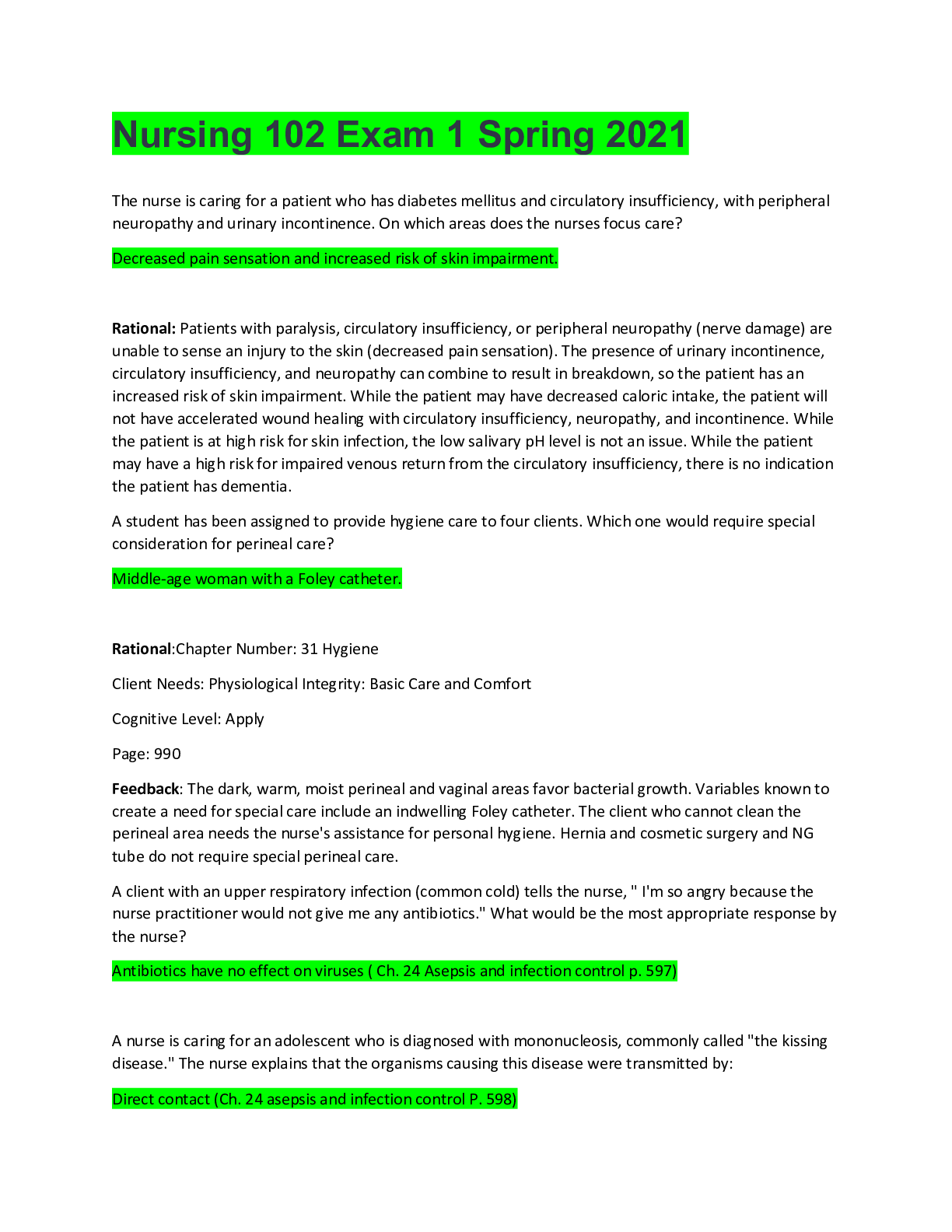
Reviews( 0 )
Document information
Connected school, study & course
About the document
Uploaded On
May 15, 2021
Number of pages
11
Written in
Additional information
This document has been written for:
Uploaded
May 15, 2021
Downloads
0
Views
45

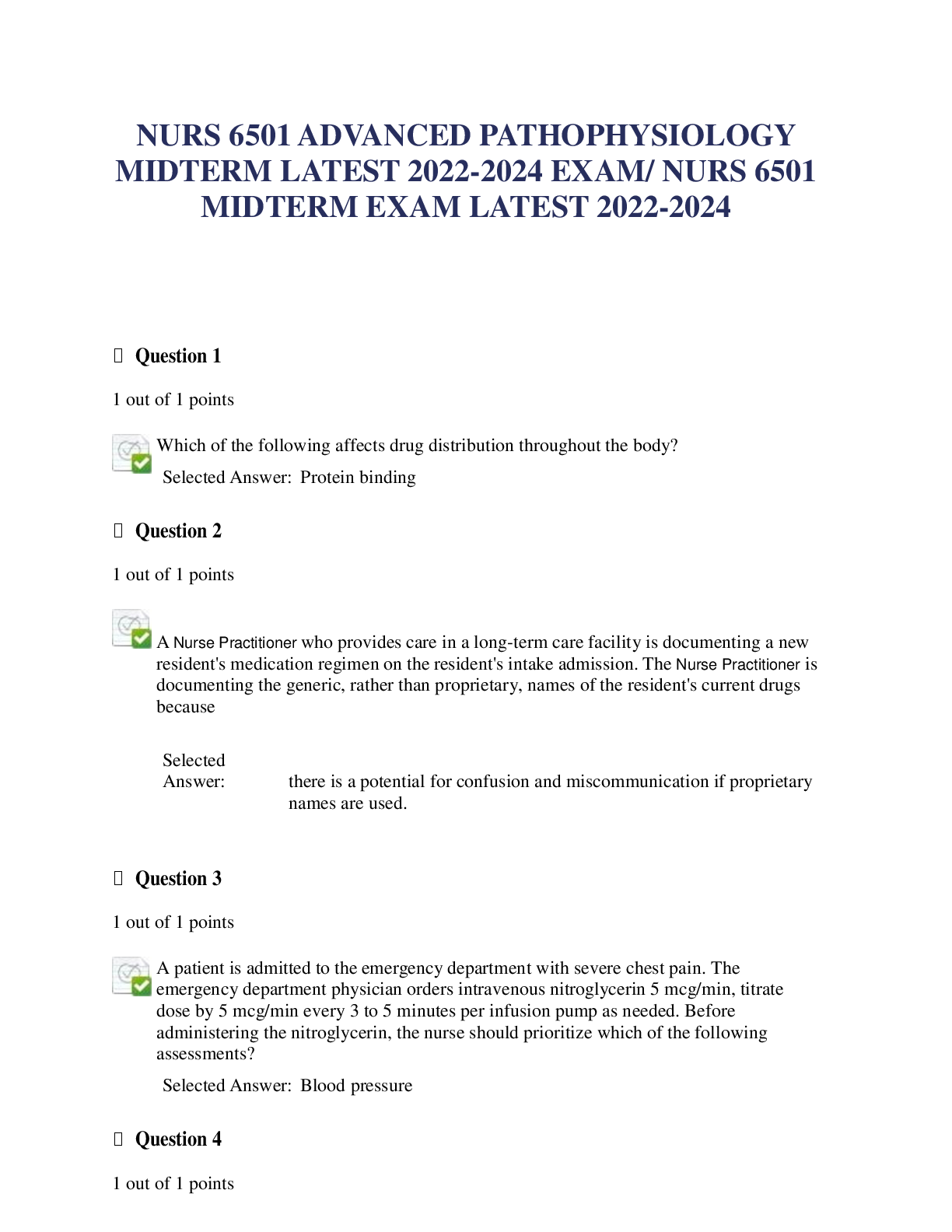
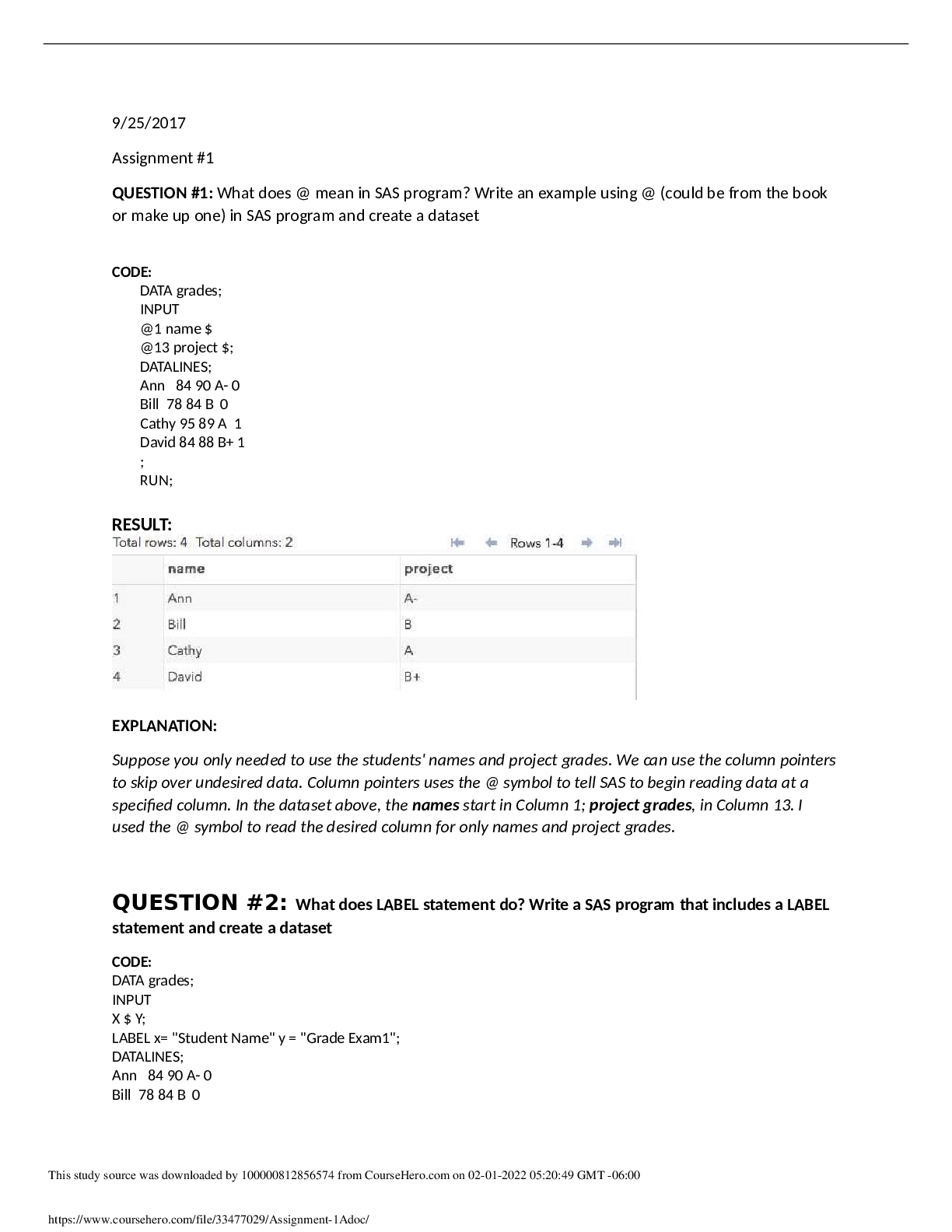
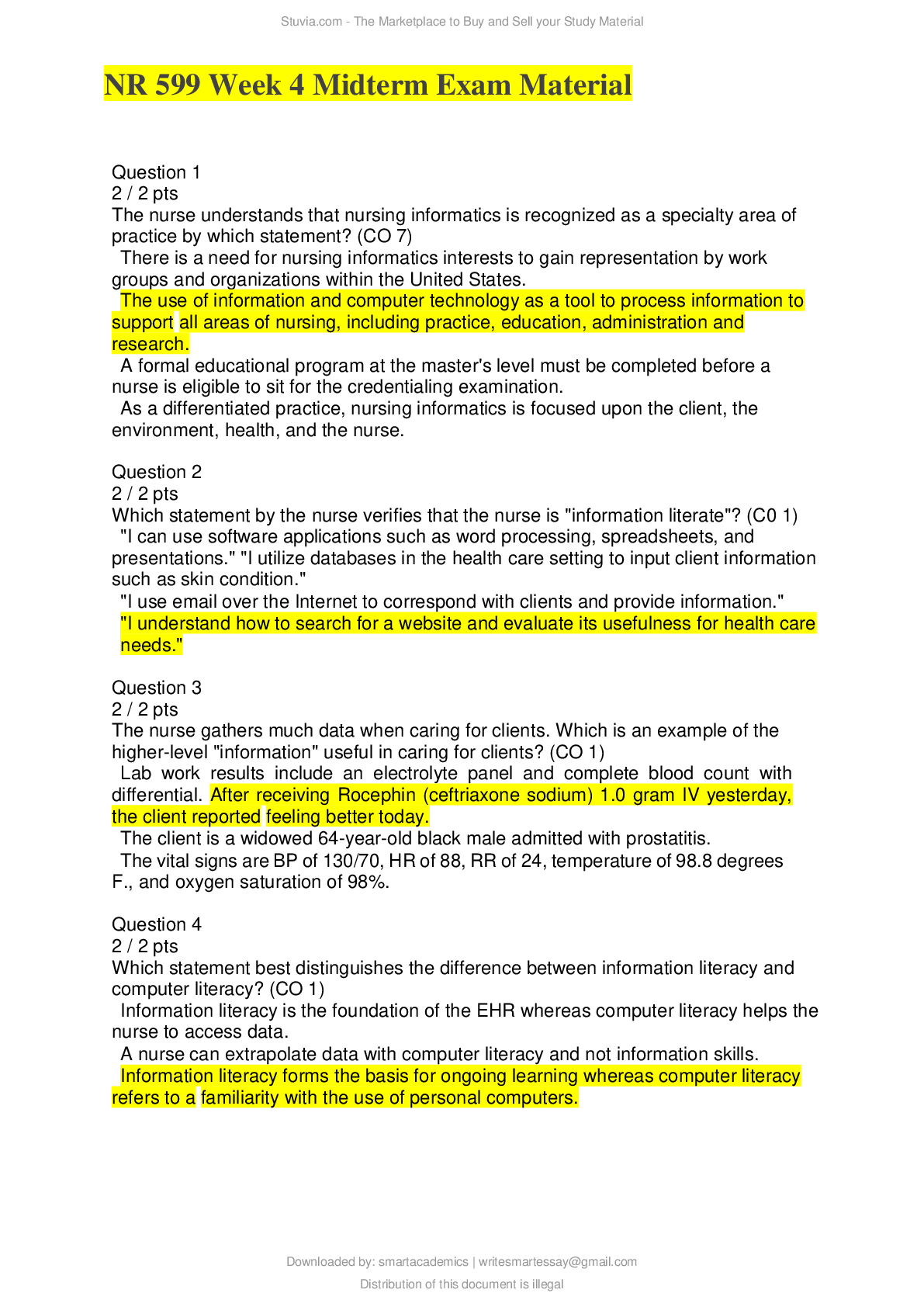
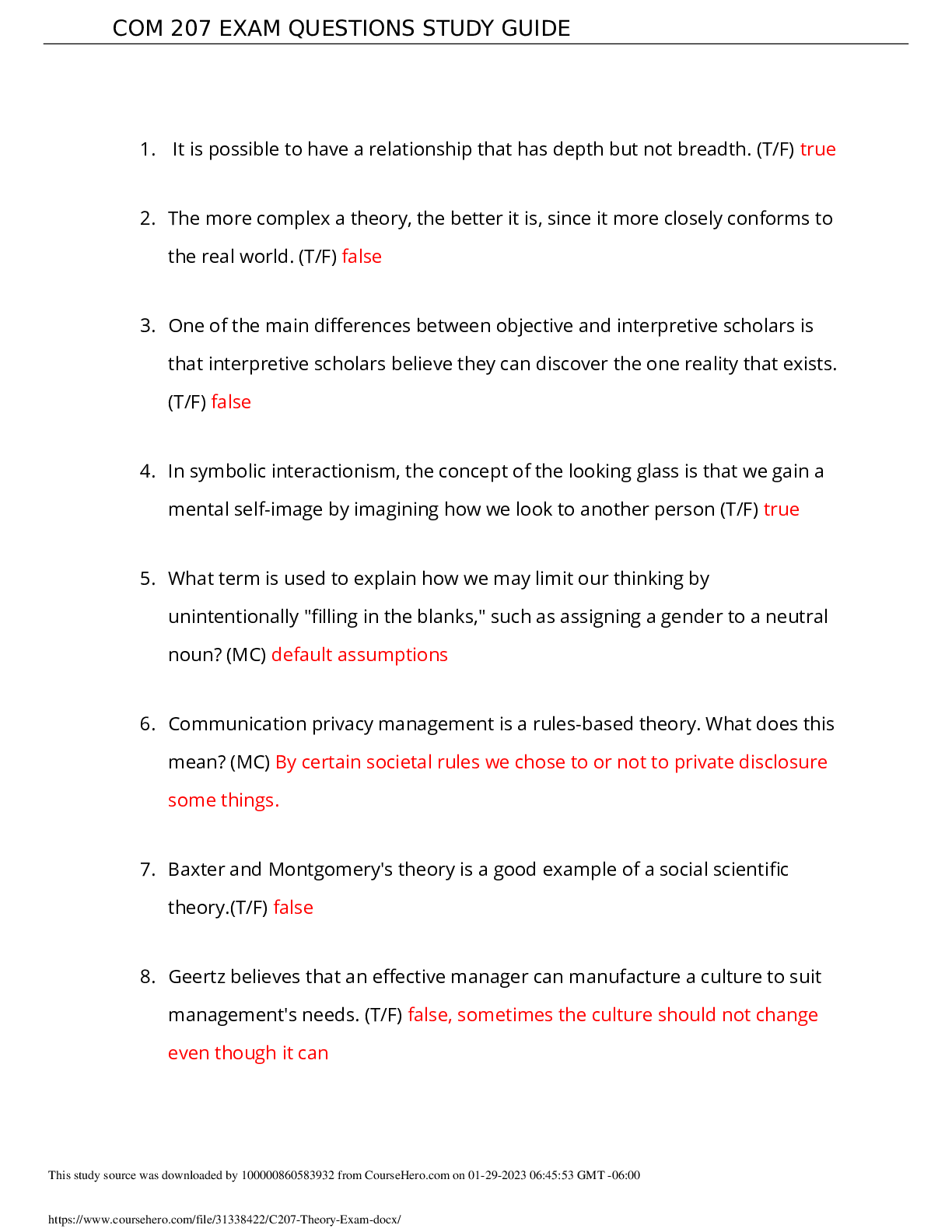
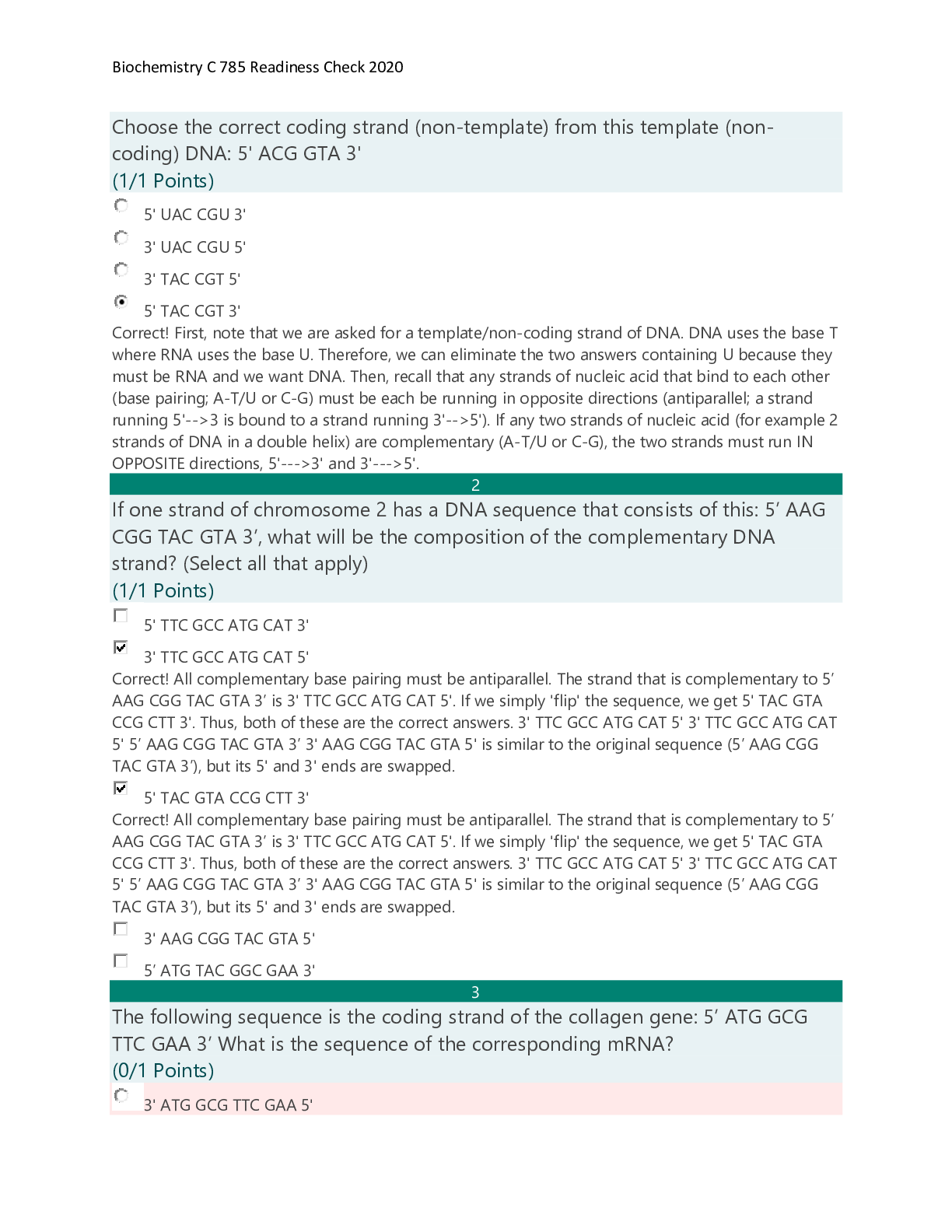
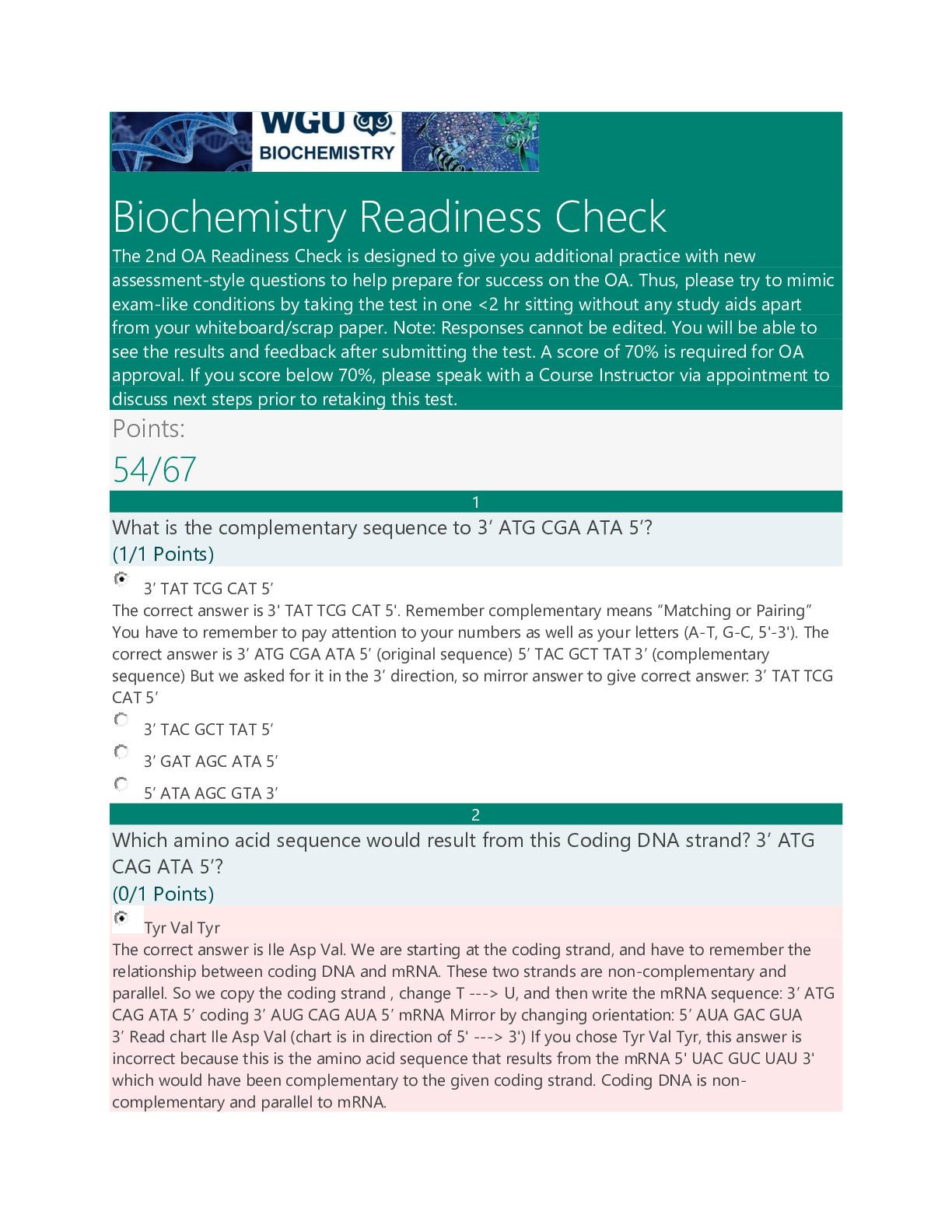
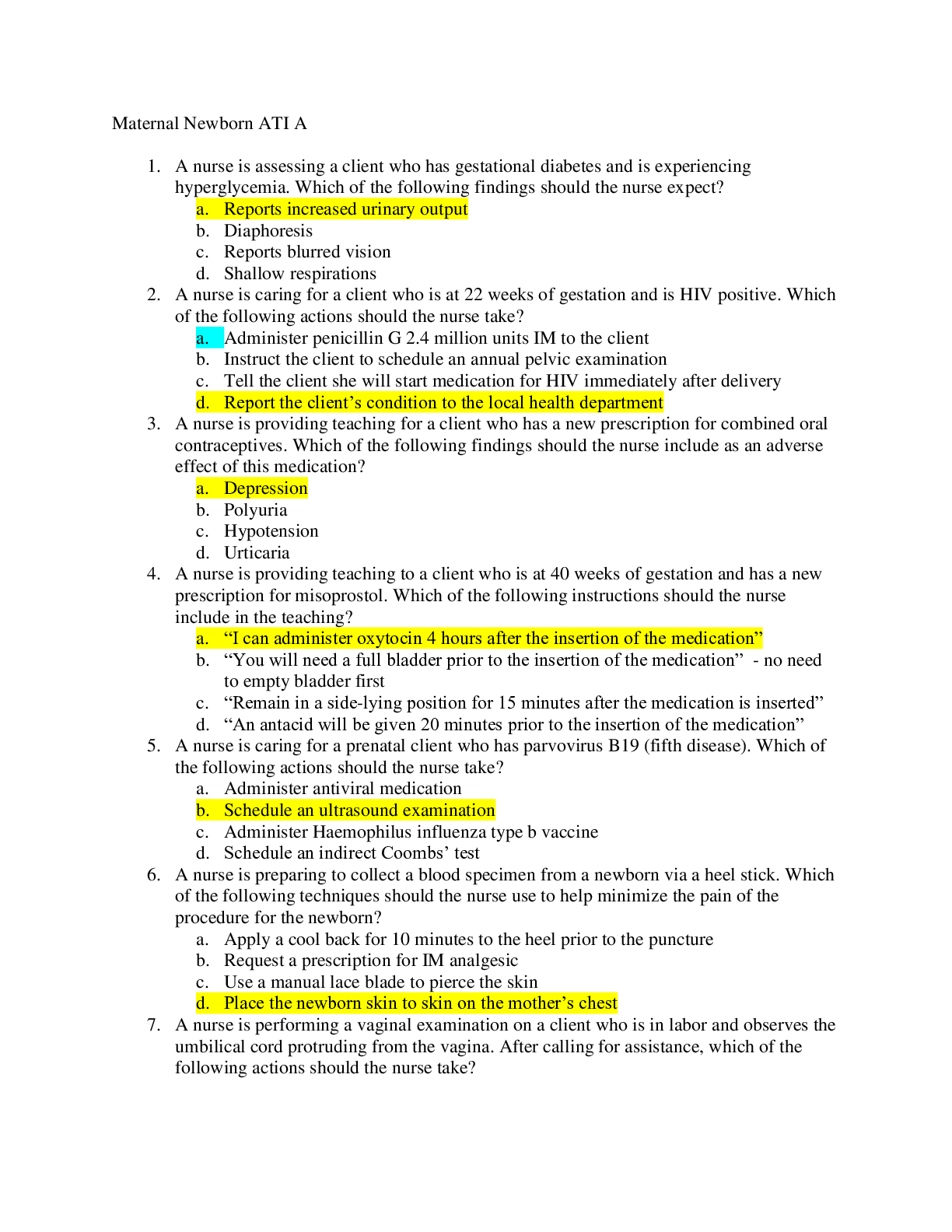

.png)

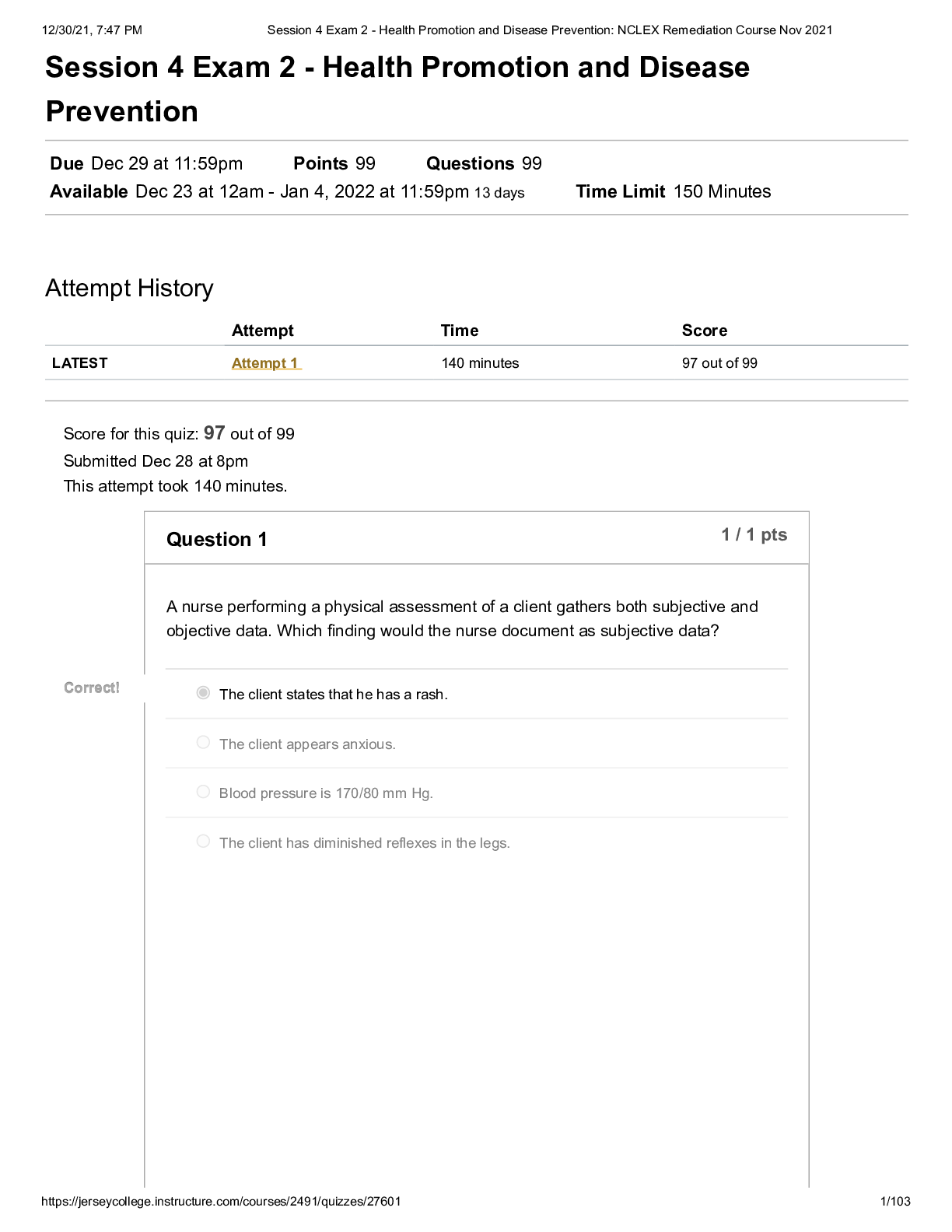
 ORGMED ORGANIC PHARMACEUTICAL PHARMACY.png)
